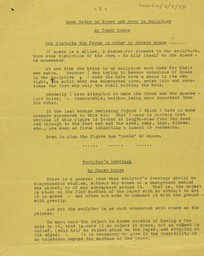Scale at Any Size: Henry Moore and Scaling Up
Rachel Wells
Moore’s sculpture, as well as his discussion of it, presents an intriguing and complex attitude towards scale. His approach towards ‘scaling up’ is considered here through a discussion of his early photography and later use of polystyrene to enlarge works.
Everything I do is intended to be big, and, while I’m working on the models, for me they are life-size. When I take one in my hand like this, I am seeing and feeling it as life-size ... So in my mind there’s never any change of scale at all.1
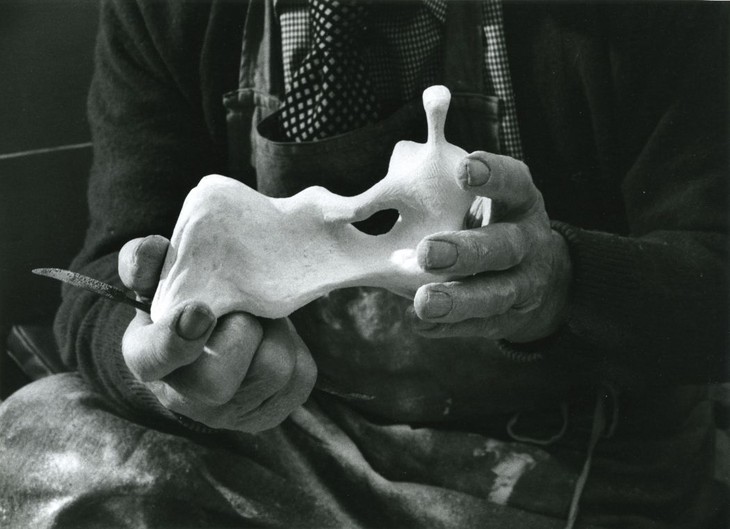
Moore holding the plaster Maquette for Reclining Figure: Hand 1976, in 1976
© The Henry Moore Foundation. All Rights Reserved
Photo: Henry Moore Foundation Archive
Fig.1
Moore holding the plaster Maquette for Reclining Figure: Hand 1976, in 1976
© The Henry Moore Foundation. All Rights Reserved
Photo: Henry Moore Foundation Archive
Yet, according to Moore, when holding a maquette in this way, he was ‘seeing and feeling it as life-size’: ‘in my mind there’s never any change of scale at all’. The difference in scale between hand-held object and towering final sculpture is denied, and equally the difference in scale between small maquette and sculptor’s hands is overlooked. This paradoxical holding of the life-size within his hands is indicative of an apparent contradiction within Moore’s approach to the issue of scale. On the one hand, there is Moore’s persistent use of enlargement, which from the late 1960s was often achieved through the use of polystyrene models. On the other, there is the declaration from Moore that to him as sculptor, no change of scale occurred between a hand-held model and its colossal counterpart.2 Scale was paradoxically the same at any size. This essay will propose that there are several explanations for this apparent contradiction – explanations that reveal much about Moore’s attitude to scale, artistic vision, distance, and the socio-historical conditions in which he worked.
Moore’s denial of his own recognition of scale change can be said to be due in part to his particular understanding of the word ‘scale’. For Moore, ‘scale’ could be entirely detached from physical size. While in common usage ‘scale’ and size’ are frequently used interchangeably rather than clearly differentiated, their relatedness is generally assumed. Recent writing by contemporary art historians has consistently defined size and scale in terms of each other, even when both terms are contested and individual definitions vary quite extensively. Anne M. Wagner, writing about Moore’s work in 2011, proposed that ‘scale is the appearance of size, which may or may not stand up to verification by objective means’.3 Wagner here emphasises the role of perception within the concept of scale: ‘the scale of an object is how big or small it looks’.4 T.J. Clark has defined size as literal, while scale, he claims, is ‘unabashedly metaphorical’.5 His account emphasises the ‘primordial’ comparison of the body to an object in the assessment of size, which he claims to be ‘immediate’ and ‘given in the nature of things’. Scale, by contrast, ‘accepts size as a mere effect of representation’.6 Both Wagner and Clark emphasise scale as relational and comparative, with Wagner also suggesting its inherent instability. In 2008 Norman Bryson similarly aligned scale with the metaphorical, subtle and flexible; it is ‘more agile’ than what he terms rather derisively as ‘mere size’.7 I have proposed elsewhere that scale is a matter of quantitative difference, while size is one of qualitative difference: scale is a difference in number, while size is a difference in kind.8 The variations in these accounts aside, all of them differ from Moore in his assertion that scale and size are divorceable.
For Moore, as for many of his contemporaries including Barbara Hepworth, scale did not conform to any of these definitions. Rather, ‘scale’ was an admirable attribute of an art object and a qualitative achievement on the part of the artist. As Hepworth once stated, ‘When we say that a great sculpture has vision, power, vitality, scale, poise, form or beauty, we are not speaking of physical attributes’.9 The implication is that scale is as elusive and difficult to define as ‘vision’, ‘poise’ or ‘beauty’; it is, along with these attributes, a rather mystical, intangible trait, and notably one which is as dependent upon the subjective assessment of a viewer as much as upon an inherent aspect of an object. Moore’s own writings suggest that he concurs with this attitude of Hepworth, and also reveal an implied connection between ‘scale’ and monumentality. Monumental scale, he wrote, can describe an object of any size, and is a ‘quality’ that ‘all the great painters, artists and sculptors have’.10 Such a ‘monumental sense’ is a ‘very rare thing’, and does not derive from ‘actual physical size’:
When the work has this monumentality about it, then you can enlarge it almost to any size you like, and it will be alright; it will be correct ... But I don’t know; I can’t explain what it is that gives monumental scale to something. I think it’s an innate vision, a mental thing rather than a physical thing. It’s in the mind rather than the material.11
For Moore, then, scale was an attribute of a great work of art, and a sign of a great artist. As such, it could exist at any size: ‘there is a side to scale not to do with its actual physical size, its measurement in feet and inches – but connected with vision’.12 ‘Scale’ is not necessarily related to size in Moore’s use of the word; rather he claimed that ‘there’s a mental scale independent of the actual physical size’.13
Moore’s emphasis upon scale as a ‘mental rather than physical thing’ and his privileging of the artist’s vision, presents a second explanation as to how he could paradoxically see and feel maquettes as life-size. Indeed, Moore’s conception of scale can here be understood as an effect of the importance he placed on the ‘mind’s eye’, an emphasis that led Wagner notably to discuss Moore’s vision as ‘scaleless’.14 In a discussion of Moore’s early working process, Wagner suggests:
To understand Moore as a maker means starting with an idea with someone constantly looking about him, especially down, then pocketing his finds for inspection later on. The habit was his way of bringing bits of the world up close. Never mind that doing so meant stripping away an object’s natural context, its fixity, in favour of a new and oddly placeless, scaleless vision; its new surroundings were not the studio, but the mind’s eye.15
This vision that is ‘scaleless’ for Wagner might be the very definition of scale for Moore: while for Wagner scale is a relational, comparative, and unstable perception of size, as outlined above, for Moore it was a rare and valuable potential within an artist and a revered subjective attribute of an artwork. Indeed, as I shall argue in more detail later, ‘bringing bits of the world up close’ was inextricably linked to Moore’s sense of monumental scale.
This contrast between understandings of ‘scale’ is indicative of that between the visionary nomadism of modernist sculpture as identified by the art historian Rosalind Krauss and the physically sited artwork that prompted a shift towards the postmodern. Modernist sculptors were criticised by Krauss in her 1979 attack on the placeless, nomadic nature of their work: Moore’s ‘scaleless’ vision resonates with the mysterious tabula rasa which Krauss identified as being rejected and overturned by a postmodern interest in site-specificity.16 In her famous essay ‘Sculpture in the Expanded Field’, Krauss argued that modernist sculpture was ‘functionally placeless and largely self-referential’, depicting its own autonomy, and happily exploring ‘a kind of idealist space’, a ‘domain cut off from the project of temporal and spatial representation’.17 The isolationism of scale in Moore’s account of it, and the autonomy he awards it from physical size, appear to be in line with a critique that he was making auratic art objects that were majestically separate from the social, economic and historic conditions in which they were made. Indeed, there is a marked contrast between Moore’s discussion of scale in 1960 and that of the American artist Robert Morris only seven years later. Morris, one of the minimalist artists championed by Krauss as presenting a postmodernist expansion of the field of sculpture, gives a phenomenological definition that applies notably to the viewer as much as to the artist:
The awareness of scale is a function of the comparison made between that constant, one’s own body size, and the object. Space between the subject and object is implied in such a comparison.18
Morris’s definition presents a very different conception of scale to that used by Moore and Hepworth. Scale here is an objective comparative measurement, rather than an innate mental vision. For Morris, the perception of scale is fundamentally physical, and is arrived at through an understanding of three key elements: the viewer’s body, the object, and the ‘space’ or distance between the two. Within this context, then, to be ‘scaleless’ in the terms of Krauss’s argument would be to be woefully disinterested in either an individual physical or a collective socio-historical particularity of context. Bringing objects ‘up close’ and isolating them in the artist’s scaleless hands can be read as a sign of a modernist emphasis upon the mind’s eye. The comparative, relational aspect of scale in Morris’s, and in more recent definitions, is not present in Moore’s insistence upon the artist’s vision.
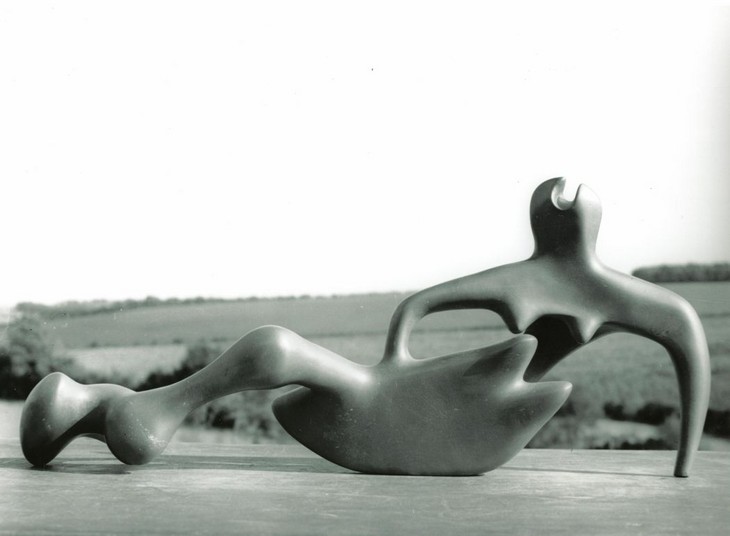
Yet Moore’s discussion of scale does suggest a consistent interest in the effects of distance. The contradiction between enlargement and scalelessness in Henry Moore’s later work, which is connected to the close-up nature of Moore’s working process identified by Wagner, is due to Moore’s attitude to distance. The ‘placeless, scaleless’ vision identified by Wagner is notably diagnosed as a result of Moore’s desire to view objects up close, suggestive of a tendency to eliminate distance. Moore’s readiness to play with distance in order to achieve his own ‘monumental vision’ is evident from early on in his practice. In 1937 and again in 1938 Moore famously photographed maquettes for two Reclining Figure sculptures very close to the lens, so as to make each diminutive object look enormous against the distant landscape (fig.2). Elizabeth Brown has interpreted these photographs as ‘tests’ to gauge the suitability of these sculptural ideas for subsequent enlargement.19 However, given Moore’s claims to experience his maquettes as life-size, and to create ‘scale’ at whatever size, it is perhaps more likely that these photographs are not so much tests as they are declarations of triumph: they are demonstrations of his sense of the monumental. Rather like physically lifting objects from the ground and holding them close to himself, here Moore brings the maquette so close to the lens (and therefore the viewer) that its monumental scale is confirmed.
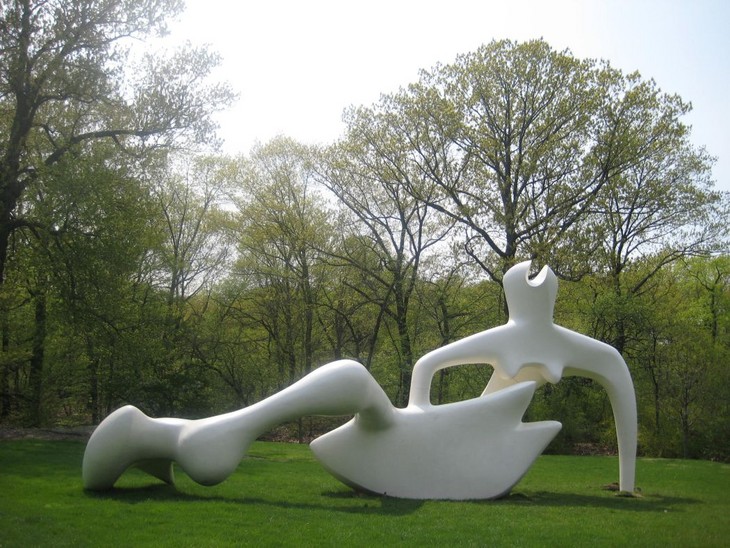 As if to prove his thesis that scale can exist at any size, Moore notably made large-scale versions of his maquette, which he entitled Large Reclining Figure (fig.3). The photographed maquette was translated into three colossal sculptures: one for the architect I.M. Pei’s site in Singapore, one for his home and studio at Perry Green, and a white fibreglass cast for use in exhibitions. Thus, a 1938 lead maquette measuring 33 cm in length was enlarged into a 1984 fibreglass sculpture measuring approximately 900 cm in length. The small dark form that Moore could hold in his hands ‘grew’ into a large white ethereal sculpture, prompting viewers to look up, and walk around and underneath it. The comparison demonstrates, among other things, the consistency of Moore’s desire to make large sculpture; further, perhaps, his desire to make sculpture at different sizes. As curator Anita Feldman has noted, while Moore’s sculpture increased in size in the decades following the Second World War, and particularly in the late 1960s and 1970s, it is clear that Moore had envisaged his work on a large scale since the 1930s.20 As well as using photography to imagine the enlargement of his carvings and maquettes, Moore was excited by the ease with which blocks of stone could be photographed so as to appear enormous and stoic, reminiscent of ancient monuments such as Stonehenge.21 Feldman notes, too, how Moore’s drawings from this period also demonstrate a desire to create large scale works, as they depict ‘powerful sculptures against dramatic imaginary rocky landscapes’.22 Contrary to the American critic Barbara Rose’s scathing criticism of 1960s ‘blow ups’, which she saw as a direct result of committee commissioning, an ignorant public’s readiness to be impressed by enormous size, and the prevalence of photography’s easy enlargements, Moore’s early photography presents an unwavering determination to demonstrate his monumental sense of scale through creating artworks at many different sizes.23 Rather than the result of an opportunistic, lucrative industry and an easily-wowed public, Moore’s large-scale work should be read alongside his earlier and more diminutive pieces as a consistent preoccupation with monumental vision.
As if to prove his thesis that scale can exist at any size, Moore notably made large-scale versions of his maquette, which he entitled Large Reclining Figure (fig.3). The photographed maquette was translated into three colossal sculptures: one for the architect I.M. Pei’s site in Singapore, one for his home and studio at Perry Green, and a white fibreglass cast for use in exhibitions. Thus, a 1938 lead maquette measuring 33 cm in length was enlarged into a 1984 fibreglass sculpture measuring approximately 900 cm in length. The small dark form that Moore could hold in his hands ‘grew’ into a large white ethereal sculpture, prompting viewers to look up, and walk around and underneath it. The comparison demonstrates, among other things, the consistency of Moore’s desire to make large sculpture; further, perhaps, his desire to make sculpture at different sizes. As curator Anita Feldman has noted, while Moore’s sculpture increased in size in the decades following the Second World War, and particularly in the late 1960s and 1970s, it is clear that Moore had envisaged his work on a large scale since the 1930s.20 As well as using photography to imagine the enlargement of his carvings and maquettes, Moore was excited by the ease with which blocks of stone could be photographed so as to appear enormous and stoic, reminiscent of ancient monuments such as Stonehenge.21 Feldman notes, too, how Moore’s drawings from this period also demonstrate a desire to create large scale works, as they depict ‘powerful sculptures against dramatic imaginary rocky landscapes’.22 Contrary to the American critic Barbara Rose’s scathing criticism of 1960s ‘blow ups’, which she saw as a direct result of committee commissioning, an ignorant public’s readiness to be impressed by enormous size, and the prevalence of photography’s easy enlargements, Moore’s early photography presents an unwavering determination to demonstrate his monumental sense of scale through creating artworks at many different sizes.23 Rather than the result of an opportunistic, lucrative industry and an easily-wowed public, Moore’s large-scale work should be read alongside his earlier and more diminutive pieces as a consistent preoccupation with monumental vision.

Photograph taken by Henry Moore of the lead maquette for Reclining Figure 1938
© The Henry Moore Foundation. All Rights Reserved
Photo: Henry Moore Foundation Archive
Fig.2
Photograph taken by Henry Moore of the lead maquette for Reclining Figure 1938
© The Henry Moore Foundation. All Rights Reserved
Photo: Henry Moore Foundation Archive
Yet Moore’s discussion of scale does suggest a consistent interest in the effects of distance. The contradiction between enlargement and scalelessness in Henry Moore’s later work, which is connected to the close-up nature of Moore’s working process identified by Wagner, is due to Moore’s attitude to distance. The ‘placeless, scaleless’ vision identified by Wagner is notably diagnosed as a result of Moore’s desire to view objects up close, suggestive of a tendency to eliminate distance. Moore’s readiness to play with distance in order to achieve his own ‘monumental vision’ is evident from early on in his practice. In 1937 and again in 1938 Moore famously photographed maquettes for two Reclining Figure sculptures very close to the lens, so as to make each diminutive object look enormous against the distant landscape (fig.2). Elizabeth Brown has interpreted these photographs as ‘tests’ to gauge the suitability of these sculptural ideas for subsequent enlargement.19 However, given Moore’s claims to experience his maquettes as life-size, and to create ‘scale’ at whatever size, it is perhaps more likely that these photographs are not so much tests as they are declarations of triumph: they are demonstrations of his sense of the monumental. Rather like physically lifting objects from the ground and holding them close to himself, here Moore brings the maquette so close to the lens (and therefore the viewer) that its monumental scale is confirmed.

Henry Moore
Large Reclining Figure 1984
© The Henry Moore Foundation. All Rights Reserved
Photo: Anita Feldman, Henry Moore Foundation Archive
Fig.3
Henry Moore
Large Reclining Figure 1984
© The Henry Moore Foundation. All Rights Reserved
Photo: Anita Feldman, Henry Moore Foundation Archive
A comparison between the 1938 photograph and the 1983 sculpture reveals more about Moore’s attitude towards distance, however, than a simple desire to eliminate it by bringing objects up close. The photographed lead maquette in the two-dimensional image can only be read as a large sculpture if it is also perceived as more distant from the lens than it actually was; photography allows ‘enlargement’ of the object only by introducing distance. The tell-tale signs of the actual size of the photographed object – the large coarseness of the grains of wood on which the object stands, the hazy lack of background focus – can be overlooked only if the object is imagined as both larger and further away from the camera than in reality it was. The latitude of the sculpted object, its spidery arching over the ground, remains the same in photographed maquette and large-scale sculpture, but the size of that ground shifts underneath it as the viewer realises the illusory nature of the great distance that Moore’s photographic trickery has imposed. In scaling-up, then, Moore was not altering the ‘scale’ of the sculpture, but was offering viewers an opportunity to view the object close-up. The larger the object, the closer the viewer can feel to it, as if – to use a photographic term – zooming in themselves. Even Moore could reach a closer relationship to an object by standing next to it, looking up, than by holding it in his hands. Like a powerful human microscope, Moore’s enlargements act as an extension of his desire to pick up small fragments of earth, of bone, of matter, and bring them to himself. Indeed, Moore’s desire to create large-scale sculpture as early as the 1930s can be read as in line with his broader interest in the microscopic; in 1934 the poet an critic Geoffrey Grigson famously detected a ‘contemporary visual experience of the anatomical details and microscopical forms of life’ in Moore’s work that ‘comes to us, not direct but through the biologist’.24 Moore’s consistent use of enlargement suggests that he was looking to enact the revelatory power of the microscope himself.
The process of scaling-up his maquettes into large sculptures changed within Moore’s late large work. Increasingly, his studio relied upon polystyrene as a means of creating the final object. As Wagner has noted, Moore was introduced to the use of polystyrene as a means of scaling-up by one of his assistants, Derek Howarth, at the start of a period in which Moore’s work grew considerably in size. Wagner has noted the practical benefits of the material – its speeding up of the process and its lightweight flexibility – as well as its visual effects: the resulting sculpture had more of a ‘weightless illusionism and a smooth, less marked surface, which combined to create a ‘polystyrene look’.25 Moore himself claimed that using polystyrene instead of plaster ‘saved a lot of time, energy and effort’, and although polystyrene was more vulnerable to damage, it allowed alterations to be made easily, and was so light that he could move large forms around on his own.26 The use of polystyrene also, Wagner argues, distanced the sculpture from the hands of its creator, as it could be shaped with a heated wire held between two people, rather than by the rough-hewn moulding of the artist’s hands. Indeed, there is some irony in the similarities between the Victorian pointing system that Moore had always rejected as an overly mechanical means of enlargement, and his assistants’ use of a grid system to plot Moore’s later large scale-work onto the polystyrene forms: Moore’s desire to maintain the lively, electric trace of the artist’s hand and vision seems compromised. Yet the distance between sculptor and final object became all the smaller, the bigger the forms that this polystyrene method enabled. For Moore, polystyrene offered enlargement without the cost of imposed distance that was paid by his early photographs such as that of the maquette of Reclining Figure viewed against the Kent landscape. Indeed, there is a sense in which polystyrene became Moore’s camera, a means by which his vision could be realised. As a strangely weightless, otherworldly form, not earthed in the same way as Moore’s other materials, polystyrene presents a certain ‘illusionism’, which suggests a parallel between camera and polystyrene model: illusionism resonates with the photograph’s play with the pitfalls of perception. As a strangely alien form, polystyrene, like the unreality of Moore’s Kent set-up, is well-suited to generating the artist’s idealist vision.
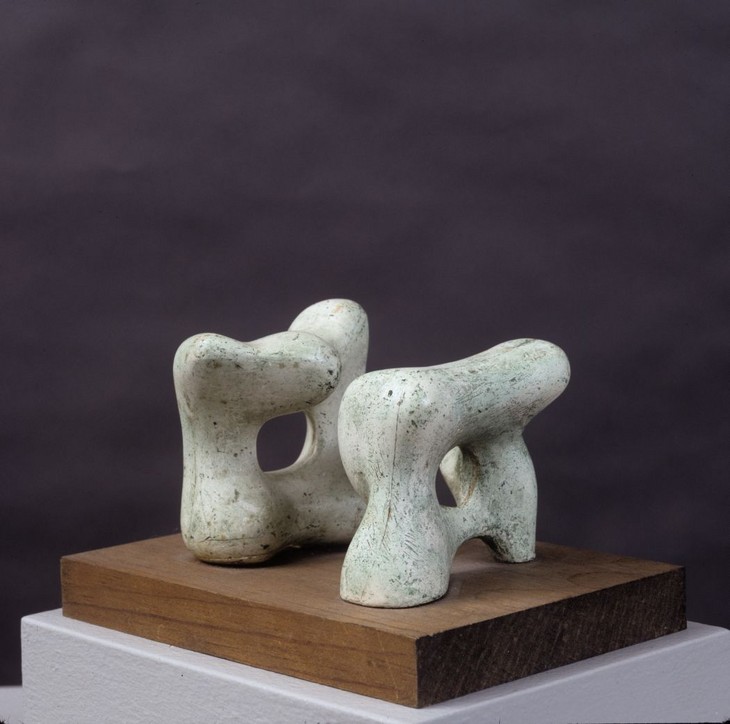
Henry Moore
Maquette for Large Two Forms 1966, photographed in the Maquette Studio at Perry Green
© The Henry Moore Foundation. All Rights Reserved
Photo: Mike Bruce
Fig.4
Henry Moore
Maquette for Large Two Forms 1966, photographed in the Maquette Studio at Perry Green
© The Henry Moore Foundation. All Rights Reserved
Photo: Mike Bruce
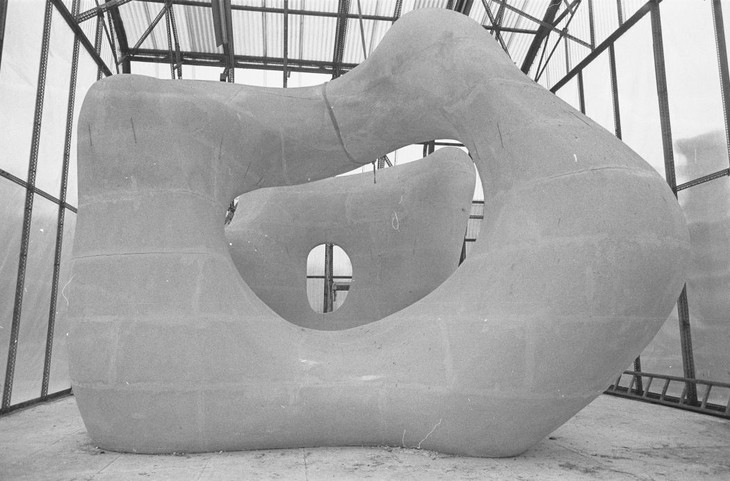
Polystyrene enlargement of Henry Moore's Two Large Forms 1966, photographed in the Plastic Studio at Perry Green
© The Henry Moore Foundation. All Rights Reserved
Photo: Errol Jackson
Fig.5
Polystyrene enlargement of Henry Moore's Two Large Forms 1966, photographed in the Plastic Studio at Perry Green
© The Henry Moore Foundation. All Rights Reserved
Photo: Errol Jackson
A comparison between Moore’s maquette, polystyrene enlargement, and final sculpture of Large Two Forms (1966) reveals both the extent of the ‘polystyrene look’ and an important insight into Moore’s approach to scaling-up. The maquette presents the two forms in a creamy plaster mottled by green markings (fig.4). Each form seems to echo but mutate the other: both stand upright, with a rounded hole at the heart of each, but with different protrusions and hollows, as if in gentle dialogue. They both stand upon the brown wood of a plinth, its dark grains revealing the small size of the maquette. The polystyrene enlargement has a very different surface, almost breeze-block like in its revelation of its own polystyrene-brick construction. The echoing of the forms remains, with the rounded elements rendered all the more bulbous by the smoothness of the surface (fig.5). This building up of the polystyrene form reflects Moore’s attitude to the process of scaling-up itself. With his dislike of mechanical means of enlargement, such as the pointing machine, Moore thought that alterations would often need to be incorporated during the enlargement process:
When the work has this monumentality about it, then you can enlarge it almost to any size you like, and it will be alright, it will be correct. But in doing it, if a thing becomes bigger than life-size, then as you stand and look at it, the angle that you might look at the head will be different from what you’d look at if it were small. Therefore it might need some alteration to give you the same feeling that you’d get from it if it were a different size. As you make a thing bigger or smaller, you alter to keep true to the mental vision you’ve had of it.27
Again, then, the mental vision is treasured most highly, and changes are made only to retain sameness with the ‘feeling’ inspired by the model. In this view, Moore was perhaps influenced by his interest in D’Arcy Thompson’s On Growth and Form (1917), with its premise that ‘growth deserves to be studied in relation to form’.28 The process of scaling-up, of ‘growth’ as such, was always a secondary, necessary concern, rather than an interest in itself. As scale could exist at any size, enlargement was a means to an end; increasingly in Moore’s later work, polystyrene offered a quick and easy method of reaching it.
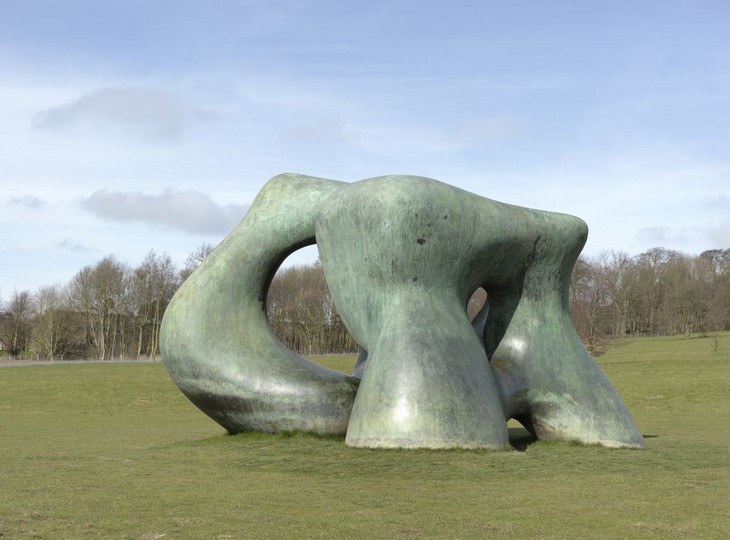 Nevertheless, polystyrene did make its own mark. The final bronze Large Two Forms, measuring 360 x 610 x 435 cm, retains a sense of both the lightness and smoothness of the polystyrene model (fig.6). Further, by allowing Moore and his assistants to scale-up sculptures with ease, the increasingly large size of Moore’s late work overcomes the imposed distance between viewer and sculpture that Moore had to imply with his early photographs of maquettes. The two bronze forms, standing directly on the ground and reflecting light in their minty bronze, encourage the viewer to weave around and in between them, to stand close and to touch the flowing surfaces that are marked by gold and orange patina. The polystyrene-enabled enlargement charges the forms with the same monumentality that Moore declared through his photographed maquettes of Reclining Figures, but here there is a drawing in of the viewer to reach close to the space and surface of the sculpture. Polystyrene realised, just as photography’s captured shadows had done in 1938, the scaleless, unworldly view of Moore’s mind’s eye. Both photography and enlargement enabled the monumentality that Moore sought, but enlargement also offered the physicality of the mental vision. Therefore, alongside scale in Moore’s sense of the word, it also offered the possibility of intense closeness.29
Nevertheless, polystyrene did make its own mark. The final bronze Large Two Forms, measuring 360 x 610 x 435 cm, retains a sense of both the lightness and smoothness of the polystyrene model (fig.6). Further, by allowing Moore and his assistants to scale-up sculptures with ease, the increasingly large size of Moore’s late work overcomes the imposed distance between viewer and sculpture that Moore had to imply with his early photographs of maquettes. The two bronze forms, standing directly on the ground and reflecting light in their minty bronze, encourage the viewer to weave around and in between them, to stand close and to touch the flowing surfaces that are marked by gold and orange patina. The polystyrene-enabled enlargement charges the forms with the same monumentality that Moore declared through his photographed maquettes of Reclining Figures, but here there is a drawing in of the viewer to reach close to the space and surface of the sculpture. Polystyrene realised, just as photography’s captured shadows had done in 1938, the scaleless, unworldly view of Moore’s mind’s eye. Both photography and enlargement enabled the monumentality that Moore sought, but enlargement also offered the physicality of the mental vision. Therefore, alongside scale in Moore’s sense of the word, it also offered the possibility of intense closeness.29

Henry Moore
Large Two Forms 1966
© The Henry Moore Foundation. All Rights Reserved
Photo: Jonty Wilde
Fig.6
Henry Moore
Large Two Forms 1966
© The Henry Moore Foundation. All Rights Reserved
Photo: Jonty Wilde
If Moore’s use of scaling-up was an extension of his desire to view the world up-close, then, this in some ways counters Krauss’s critique. When viewed alongside his contemporaries and seen in the context of recent writing on a modernist sense of scale by T.J. Clark, Moore’s elimination of distance becomes revealing of a wider cultural context.30 Of course, it is Alberto Giacometti, a contemporary of Moore, and whose work Moore publically admired, whose sculpture is most often discussed in terms of effects of distance. The brittle strength of Giacometti’s thin, elongated, figures has been frequently described as creating a sense of infinite distance between viewer and sculptural object. As Jean-Paul Sartre commented in his famous 1948 text The Search for the Absolute, Giacometti ‘confers on his figures an absolute distance’, so that the ‘imaginary figure is distant even when the plaster is near’. For Sartre, Giacometti’s genius lies in his ability to ‘squeeze space with distance’, as if overcoming Zeno’s paradox of infinite divisibility.31 More recently, Dieter Honisch has argued that for Giacometti, distance became ‘a precondition of experiencing the reality of a thing: seen excessively close-up – from not far enough away – the thing would dissolve into a merely arbitrary appearance.’32 Indeed, Honisch’s essay, which addresses scale in Giacometti’s sculpture, opens with a discussion of the sculptor’s difficulty between 1935 and 1945 in not making smaller and smaller sculptures, in order to communicate the extreme distance he felt from his subject, citing the sculptor’s words:
At first I had instinctively made the sculpture so small to indicate the distance from which I had seen the model. From a distance of fifteen metres, that girl was for me not eighty centimetres high, but a little over ten. And then, too, in order to convey the appearance of the whole and not lose myself in details, I had to choose an even greater distance. But even then, when I put in details, they seemed to contradict the whole ... So I moved further and further back, until at last everything disappeared.33
This statement demonstrates a constant striving to get further away, to expand and increase distance; an opposite instinct to that of Moore. However, Honisch’s analysis of this tendency in Giacometti notably diagnoses a similar scalelessness to that ascribed to Moore. Honisch claims that Giacometti’s sculpture strips the viewer of his or her previous understanding of ‘correct scale’ that has been gained through experience – the perception of scale discussed by Morris – and instead ‘orders’ the viewer back into the realm of their own imagination: ‘To this extent, the space that Giacometti’s figures generate around themselves, and which they need, is really not to be entered by those looking on. The boundary is invisible, but one can feel it.’34 This reading of Giacometti’s work places a similar importance upon the ‘mind’s eye’, and upon a mental vision, as Moore’s own understanding of his practice: there is a similar emphasis upon a placeless and scaleless condition for the art object.
Rather than this diagnosis of the scalelessness of Giacometti’s work leaving him open to Krauss’s critique, it can be argued that Giacometti’s desire to create a sense of infinite distance, and Moore’s impulse to overcome the same, are expressions of a sculptural practice that is not isolated from historical context but rather created by it. In the early 1940s Moore’s work was discussed by Grigson as the result of an interest in the microscopic, within a context of a ‘contemporary visual knowledge’ which was ‘revealed by anatomy’ and ‘through the biologist’.35 Moore’s acknowledgment of his early interest in On Growth and Form supports this reading, as Thompson’s text argues for a physico-mathematical explanation of biological growth, and references the philosopher George Berkeley’s persistent investigation of the relationship between distance and magnitude in the perception of objects in his 1709 Essay Towards a Theory of Vision.36 If Moore’s early ambitions for large-scale work should be understood in the context of a personal preoccupation with the microscopic and the effects of growth and distance, his realisation of these ambitions in his late large-scale sculpture can be read in the context of a developing widespread contemporary consciousness that was no longer thrilled by seeing the world at a microscopic level but which was increasingly both fascinated by and fearful of reaching into the realm of the atomic. I suggest that both Moore’s scaling-up and Giacometti’s scaling-down in this period can be jointly understood as reflective of a specifically Cold War sense of scale, and of what T.J. Clark has discussed as a modernist ‘opting for one idea of largeness or smallness over another’.37
In a discussion that is based primarily around what he detects as Jackson Pollock’s ‘smallness’, Clark outlines his definition of scale as metaphorical and size as literal. For Clark, Pollock’s painting expresses a ‘naive dream of literalness’, and a desire to ‘lay hold of the true size of things again’.38 The space between bigness and smallness, for Clark, is that of virtuality and scale. Clark then uses this set of terms to propose that modernist artists left little room for the intermediary, virtual realm of scale, opting instead for extremes of size. He argues that the large size of Pollock’s 1950 paintings reflects this attempt to ‘overwhelm metaphor and put the world in its place’, thereby connecting abstraction with literalness. Further, Clark suggests a connection between this understanding of size and the impact of Cold War tensions:
[Number 6 1950] wanted to create the illusion of molecular compression, of course on the verge of turning into its opposite – explosive, destructive force. (Not exploding, but reaching critical mass.) Pollock’s paintings are horrifyingly of their time. Serge Guilbaut was right to intuit in them a truly horrifying, truly horrified sense of fusion and fission, small and large, nucleus and particle scatter. What was new to the cold war sense of space was the notion – a commonplace notion, leaking uncontrollably from Los Alamos to The New Yorker – of small and large as instantly convertible, as terrible immediate transforms of each other.39
Indeed, Clark also suggests that this stark transformation of small and large was not only ‘partly nuclear, partly addressed to the world of Fermi and Teller’ but also about a ‘monstrous division of labour’: ‘Small into large may obey the logic of criticality, but, just as much, the logic of Adam Smith’.40 Thus, Clark interprets a sense of scalelessness as bound up with the historical and social conditions of both Cold War and capitalist inequalities.
References to either the tense fears of the Cold War period, or to the politics of capitalism, are missing in a critique of Moore’s sculpture that emphasises either the Yorkshireman’s idealist vision and modernist autonomy, or his exploitation of lucrative large-scale commissions with his later work. When Moore’s relationship with Cold War politics has been discussed, it has often been with a focus upon the ways in which his work, with its perceived universalism and humanism, was used as a form of cultural diplomacy.41 The most overt reference to the tragedy and insecurities of this era is Moore’s 1964 Atom Piece, in which references to both the skull and the atomic cloud – the human frame, and that capable of obliterating it – merge together into an ominously smooth, rounded crown growing out of more jagged, angular and scratched armatures beneath it. Here too, the political attitude behind the piece has been contested.42 Yet Atom Piece remains a signal that Moore was affected by the unstable events that marked the emergence and entrenchment of the Cold War, and as argued above, Moore’s desire to ‘scale-up’ was not a sign of cashing-in as much as closing-in.
If Moore’s late large-scale work presented a desire for largeness, and for an overcoming of distance, and Giacometti’s, too, was a desire to create work which tended towards smallness and a created impression of infinite distance, their work can be read jointly, along with Pollock’s and many other modernist artists, as a reaction to the unnatural lack of gradual growth and enlargement that historical events threatened to suddenly leap across. Smallness and bigness as stark ‘transforms’ of each other produce a sense of both the far and the near, the unsurpassably distant and the overwhelmingly close. Just as Clark identifies an overlooking of the virtual realm of scale in Pollock’s practice and more broadly in modernist art, for Moore, enlargement as a process was paradoxically elided even in his scaled-up works: bypassed through the weightlessness and illusionism of either photography or polystyrene, there was only ever the monumental reality of the artist’s vision. The lack of ‘grounded’ scale in Moore’s work, his ability to hold maquettes as if at life-size scale, may emphasise his commitment to his own idealist vision, but it also testifies to the socio-historical conditions from which that vision grew.
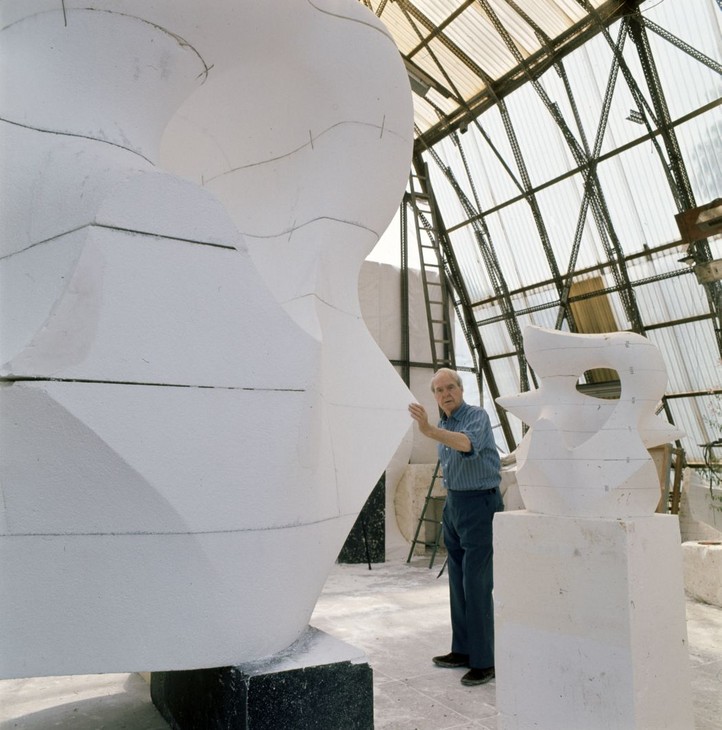
Moore with the polystyrene version of Large Spindle Piece 1974 in progress and the plaster Working Model for Spindle Piece 1974 marked up for enlargement, in the Plastic Studio at Perry Green 1974
© The Henry Moore Foundation. All Rights Reserved
Photo: Henry Moore Foundation Archive
Fig.7
Moore with the polystyrene version of Large Spindle Piece 1974 in progress and the plaster Working Model for Spindle Piece 1974 marked up for enlargement, in the Plastic Studio at Perry Green 1974
© The Henry Moore Foundation. All Rights Reserved
Photo: Henry Moore Foundation Archive
Notes
Henry Moore, interview with Donald Hall, 1960, quoted in Alan Wilkinson (ed.), Henry Moore: Writings and Conversations, Aldershot 2002, p.208.
Anne M. Wagner, ‘Scale in Sculpture: The Sixties and Henry Moore’, Tate Papers, no.15, Spring 2011, http://www.tate.org.uk/research/publications/tate-papers/scale-sculpture-sixties-and-henry-moore , accessed 15 March 2013.
T.J. Clark, ‘Pollock’s Smallness’, in Kirk Varnedoe and Pepe Karmel (eds.), Jackson Pollock: New Approaches, New York 1999, pp.15–32.
Norman Bryson, ‘Robert Therrien and the Taming Power of the Small’, in Ealan Wingate and Maureen Mahony (eds.), Robert Therrien, New York 2008, pp.135–6.
See Rachel Wells, Scale in Contemporary Sculpture: Enlargement, Miniaturisation and the Life-Size, Farnham 2013, p.6.
Barbara Hepworth quoted in Rosalind E. Krauss, Passages in Modern Sculpture, Cambridge, Massachusetts 1981, p.141.
Wagner 2011, http://www.tate.org.uk/research/publications/tate-papers/scale-sculpture-sixties-and-henry-moore , accessed 15 March 2013.
Robert Morris, ‘Objecthood and Reductivism’, in Charles Harrison and Paul Wood (eds.), Art In Theory: 1900–1990: An Anthology of Changing Ideas, Oxford 1992, p.831.
Elizabeth Brown, ‘Moore Looking: Photography and the Presentation of Sculpture’, in Dorothy Kosinski (ed.), Henry Moore: Sculpting the 20th Century, exhibition catalogue, Dallas Museum of Art, Dallas 2001, p.290.
Anita Feldman, ‘Late Large Forms’, in Henry Moore: Late Large Forms, exhibition catalogue, Gagosian Gallery, London 2012, p.18.
Barbara Rose, ‘Blow-Up: The Problem of Scale in Sculpture’, Art in America, no.56, July–August 1968.
Anne M. Wagner, ‘Moore’s Later Sculpture: The Space Between the Knuckles’, in Gagosian Gallery 2012, p.177.
This argument has implications for the exhibition contexts of Moore’s large-scale sculpture, as it suggests that his late work is seen more effectively from a close distance than it is from afar.
Jean-Paul Sartre, ‘The Search for the Absolute’, 1948, in Jon Wood, David Hulks and Alex Potts (eds.), The Modern Sculpture Reader, Leeds 2007, p.185.
Dieter Honisch, ‘Scale in Giacometti’s Sculpture’, in Angela Schneider (ed.), Alberto Giacometti: Sculpture, Paintings, Drawings, Munich and New York 1994, p.66.
Rachel Wells is Lecturer in Art History and Theory at Newcastle University.
How to cite
Rachel Wells, ‘Scale at Any Size: Henry Moore and Scaling Up’, in Henry Moore: Sculptural Process and Public Identity, Tate Research Publication, 2015, https://www

